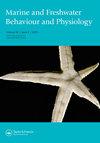印度东南部马纳尔湾的靠垫星(Culcita schmideliana)捕食珊瑚虫
IF 0.9
4区 生物学
Q3 MARINE & FRESHWATER BIOLOGY
Marine and Freshwater Behaviour and Physiology
Pub Date : 2018-03-04
DOI:10.1080/10236244.2018.1473013
引用次数: 4
摘要
珊瑚虫在珊瑚礁生态中起着至关重要的作用。在印度水域,其他生物对珊瑚的捕食还没有得到适当的研究。本文报道了在印度东南部的马纳尔湾(GoM)首次观察到垫星(Culcita schmideliana)捕食珊瑚虫。我们在墨西哥湾进行定期的水下调查时,发现C. schmideliana在Vilanguchalli斑礁3米深处捕食硬珊瑚Acropora formosa和软珊瑚Sarcophyton sp.。虽然在水下经常发现施米蝇,但在墨西哥湾还没有观察到施米蝇捕食珊瑚。除海草(8.36%)和软珊瑚(6.11%)外,捕食区主要有硬珊瑚(50.21%)。温度异常和随之而来的珊瑚白化可能是施米氏蝽偏爱珊瑚虫的原因。本文章由计算机程序翻译,如有差异,请以英文原文为准。
Cushion star (Culcita schmideliana) preys on coral polyps in Gulf of Mannar, Southeast India
Abstract Corallivore animals play vital role in coral reef ecology. Predation on corals by other organisms has not been studied properly in the Indian waters. This study reports the first observation of predation by cushion star (Culcita schmideliana) on coral polyps in Gulf of Mannar (GoM), southeast India. During our regular underwater surveys in GoM, C. schmideliana was found preying on hard coral Acropora formosa and soft coral Sarcophyton sp. at a depth of 3 m in Vilanguchalli patch reef. Though C. schmideliana has been sighted often under water, it has not been observed to predate on corals in GoM before. The area where predation was observed has a major population of hard corals (50.21%) besides seagrasses (8.36%) and soft corals (6.11%). Temperature anomalies and the consequent coral bleaching could be the factors making C. schmideliana prefer coral polyps.
求助全文
通过发布文献求助,成功后即可免费获取论文全文。
去求助
来源期刊

Marine and Freshwater Behaviour and Physiology
生物-海洋与淡水生物学
CiteScore
2.10
自引率
0.00%
发文量
9
审稿时长
>12 weeks
期刊介绍:
Marine and Freshwater Behaviour and Physiology is devoted to the publication of papers covering field and laboratory research into all aspects of the behaviour and physiology of all marine and freshwater animals within the contexts of ecology, evolution and conservation.
As the living resources of the world’s oceans, rivers and lakes are attracting increasing attention as food sources for humans and for their role in global ecology, the journal will also publish the results of research in the areas of fisheries biology and technology where the behaviour and physiology described have clear links to the contexts mentioned above.
The journal will accept for publication Research Articles, Reviews, Rapid Communications and Technical Notes (see Instructions for authors for details). In addition, Editorials, Opinions and Book Reviews (invited and suggested) will also occasionally be published. Suggestions to the Editor-In-Chief for Special Issues are encouraged and will be considered on an ad hoc basis.
With the goal of supporting early career researchers, the journal particularly invites submissions from graduate students and post-doctoral researchers. In addition to recognising the time constraints and logistical limitations their research often faces, and their particular need for a prompt review process, accepted articles by such researchers will be given prominence within the journal (see Instructions for authors for details).
 求助内容:
求助内容: 应助结果提醒方式:
应助结果提醒方式:


